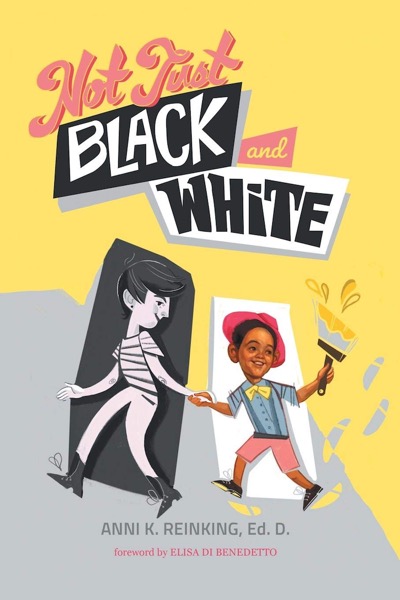
The Washington Monument and the White House are visible behind the words Black Lives Matter sign that has been painted in bright yellow letters on the 16th Street by city workers and activists, Friday, June 5, 2020, in Washington. (Photo by Khalid Naji-Allah provided for public use via Office of Mayor Muriel Bowser.)
.
‘Breathing Racism’ and the ‘Adultification’ of Young Black Americans
By ANNI REINKING
Author of ‘Not Just Black and White’
Black is darkness. Black is death. Black is scary. Black is bad. Black is feared.
How many of you grew up with those ideas as part of your socialization? We all have. This is our reality.
“We are all racism breathers,” writes Lisa Delpit in her book Multiplication is for White People: Raising Expectations for Other People’s Children. Her statement is based in work of Beverly Tatum. A psychologist, educator and author, Tatum provides a powerful metaphor of the concept of racism breathers. She explains that in the same way residents who live in highly polluted areas cannot avoid becoming “smog breathers,” Americans who are immersed in the structures and practices of white supremacy unwittingly become “racism breathers.”
Many of us may not realize the degree to which these toxic beliefs shape our perceptions and experiences of the world. Unless we have opportunities to unlearn racism, these messages become absorbed and have consequences. In a book by social psychologist Jennifer L. Eberhardt, she describes a story she heard from a police officer as she was doing training on the impact of implicit bias in society. A short version of the story is that a Black officer approached her after the training and told her that one day as he was working undercover he saw a man with dark skin who looked sketchy. He began trailing the man until he noticed, several minutes later, that he was trailing the reflection of himself in a window/mirror. He, a Black man, was trailing his reflection, as a suspect, a sketchy looking person. We all have bias.
So, we, as Americans, all grow up as racism breathers learning that black is bad. In movies, dark scenes often indicate something scary is going to happen. Many children grow up being afraid of the dark, which is internalized through socialization. What color represents mourning and/or death? Black.
I grew up, just like all other Americans, in a society that breathes racism into our bones, our blood and our mindsets.
However—this does not give us an excuse to act on our racist beliefs. While we all reflect on this concept we need to be honest with ourselves. We need to consciously work against something that has been breathed into us, just as we breath in smog in polluted areas.
Does this concept make you feel uncomfortable? I urge you to keep pushing through your discomfort.
Today, we all have witnessed murders of black persons—especially George Floyd—at the hands of police. The global outpouring is forcing all of us to confront this uncomfortable truth that, in our society and culture, “Black is scary.”
Adding to this reality is the concept that in America Black bodies are owned. The concept of owning Black bodies is embedded into the foundation of our country—on the backs of Slaves, on the backs of Black people racially profiled, on the backs of Black people murdered, whose blood is flowing through this land—and those forgotten.
We have a history to fight against, but we are strong and this fight is not over.
‘Adultification’ of Young Black Americans
This piece of writing came about because of a picture I saw on social media—one that truly spoke to me. It was the picture of a Black boy holding a sign asking why society turns their view of him from cute to scary. This happens in the blink of an eye for Black children.
Black children are “adultified” and miss out on the growing years of adolescence where mistakes can be made and people forgive, rather than kill. Black children, in the eyes of Americans, go from cute to scary in the blink of an eye. But white children? They get the advantage of the learning and growing years where people forgive and dismiss occasional misbehavior as: “Kids will be kids.”
Remember—Tamir Rice was 12 years old when he was murdered by police bullets. In the eyes of white Americans he was “adultified.” He was deemed scary because of the color of his skin. He was seen as an adult because of the color of his skin.
Remember—12-year olds are 5th and 6th graders. Think about 5th and 6th grade students. They are still children. Their brains are still forming. They are still learning about life. And for some Black children, they may be just starting to become aware of a society that is scared of them, especially because one year earlier they were seen as cute.
The adultification of Black children moves them from cute children to scary adults and skips the learning years of adolescence and young adult.
Why? Because we are racism breathers.
.
.
Care to Learn More?
Read the Rest of This Story—
You’ve read Part 1. Now, read Part 2: Dr. Anni Reinking on ‘What can I do now?’ In this second column, Anni responds directly to the question so many men and women are asking today: “What can I do now?” She doesn’t claim to have the only “right” answers. Rather, she describes tried-and-true approaches she is taking with her own family, friends, co-workers and her students.
GET A COPY OF ANNI’s BOOK
The book, Not Just Black and White is in stock at Amazon in paperback, hardcover and eBook versions as well as other online retailers.
WATCH A VIDEO TRAILER FOR THE BOOK:
WHO IS ANNI?
Anni K. Reinking is a former professor and current education consultant located in Illinois. She specializes in early childhood education, multicultural education, and trauma informed practices. She currently provides training in topics focused on poverty, trauma, multicultural education, and developmentally appropriate practice. Her research agenda has consistently focused on multicultural education and social justice. She has published or presented research in the areas of multicultural education, challenging behaviors, trauma informed practices, and creating positive school cultures, and more. She is a member of multiple state and national organizations focused on multicultural education and education.
You can learn more bout Anni’s life and work at her Amazon Author’s Page.
.
.

